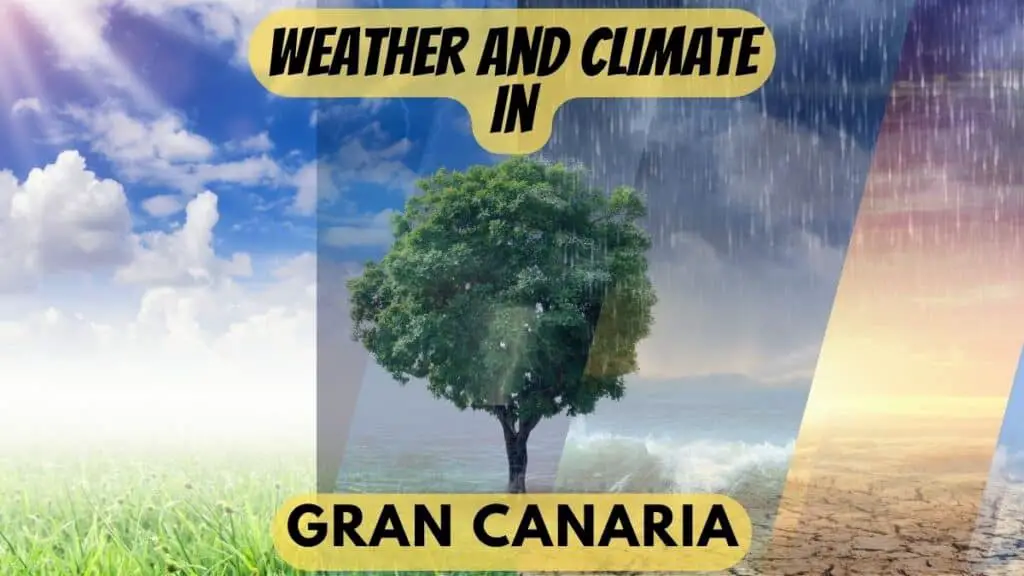When planning a vacation and choosing locations, remember that one of the major considerations for your destination is the weather and climate available. Ideally, the weather and climate will be pleasant, with plenty of sun, a clear sky, and a comfortable temperature.
If you’re planning to visit Gran Canaria or the Canary Islands, you can enjoy a subtropical climate and tour the famous beaches while enjoying an average temperature of around 70 degrees Fahrenheit and a fresh breeze off the Atlantic Ocean.
This article will explore the details of the climate and weather in Gran Canaria and the best times to plan your vacation.

Gran Canaria climate
The island of Gran Canaria lies in a climate zone known as the oceanic subtropic. This results in very mild winters and a clear sky on most days. Trade winds keep the air cool even in the hottest months, and it’s not uncommon to experience a fresh breeze and plenty of sunshine year round.
In Las Palmas de Gran Canaria – the island’s capital city – you can explore coral reefs and tourist locations while enjoying a light wind and a moderate temperature that’s kept low by humidity trade winds.
What Kind Of Temperature Does Gran Canaria Usually Have?
The temperature in Gran Canaria is generally between 60 degrees and 81 degrees Fahrenheit throughout the year.
In winter, the temperature is typically in the mid to low sixties. In summer, it tends toward the high seventies or low eighties.
How Are ‘Warm’ and ‘Cold’ Seasons Determined?
- The ‘Warm’ season generally runs from the first week of July to the second week of October, when the average temperature is in the high seventies or low eighties.
- The ‘Cold’ season generally runs from the middle of December to the first week of April, when the temperature averages below 70 degrees.
What Can I Expect of Winter Weather In Gran Canaria?
- In winter, the island is known to have a comfortable average temperature in the sixties and seventies, with very little rainfall.
- It’s also known to have strong winds, and a moderate breeze accompanies most days.
- The winter months have plenty of sunshine and very little precipitation, making it good weather for those who like it cooler.
- From September to May, you can also expect it to be partly cloudy on most days, in part due to the low-pressure weather fronts that form and drive clouds and fog banks up over the northern sides of the Canary Islands.
What Can I Expect of Summer Weather In Gran Canaria?
- Summer is known for the higher temperature – high seventies to low eighties – and higher levels of precipitation.
- There’s more rain in the summer months. If you want to visit in summer, plan for the weather with more rainfall and a higher overall temperature around the island, and pack accordingly.
- Summer has clearer days, but you should still expect it to be partly cloudy, with a chance of rain. However, Gran Canaria is known for small amounts of rainfall rather than storms, and averages about 4/100ths of an inch in precipitation, even on a ‘wet’ day forecast.
What Factors Influence The Climate In Gran Canaria?
The climate and Gran Canaria weather are influenced by a combination of trade winds and a cold current that flows offshore and makes the water much more relaxed.
The different winds that blow from north to south and vice versa create a series of low pressure and high pressure that can create higher winds and bring both rain and bright sunshine.
Different topological areas can also influence the apparent temperature, wind speed, and humidity. Conditions can also vary by location, with southern areas often being sunnier than northern and northeast regions.
What is Gran Canaria Weather Like In General?
Overall, Gran Canaria weather, as well as the weather of most of the Canary Islands, is relatively stable with a moderate breeze. However, it does vary from month to month, and it’s good to know the potential variations when planning a trip.
Related article: Which Canary Island Is the Hottest?
Different months have been known for their differences in average temperatures, wind speed, precipitation, average conditions, and the amount of available sunshine.
The weather can also vary by location and even from hour to hour. The temperature at Gran Canaria Airport at sunrise might be very different from the weather at Las Palmas de Gran Canaria in the afternoon.
Between the various environmental factors and the seasonal and monthly changes, it can get a little complicated, but the basics are as follows:
Weather in January
- January is often the coldest month of the year in Gran Canaria, with an average temperature of 60-69 degrees Fahrenheit.
- The sky is often partly cloudy, with about 31% cloud cover throughout the month. Average precipitation for the month rarely exceeds 1-2 inches.
- Humidity is generally low, with the chance for uncomfortable levels of humidity and temperature at ~1%
- Sunrise gradually comes earlier over the course of the month, generally occurring around 7:53 am at the beginning of the month and 7:49 by the end of the month (subject to astronomical adjustments)
- The average hourly wind speed is between 13.5 and 14.5 mph, which is a fresh breeze, primarily out of the northeast
Weather in February
- The temperature ranges between 65 and 75 degrees Fahrenheit.
- Often partly cloudy, with an average of about 28% cloud cover throughout the month. The average monthly precipitation rarely exceeds 1.1 inches.
- Humidity is low.
- Sunrise becomes earlier, moving from ~7:49 to 7:28 am (subject to astronomical adjustments)
- The average daily wind speed is about 14.3 mph, which is a moderate or gentle breeze.
Weather in March
- Average temperatures fall between 60 and 71 degrees Fahrenheit
- The sky generally has some cloud cover, but the amount gradually decreases to about 24% overcast conditions by the end of the month. You’ll begin to have more clear sky days.
- Humidity remains relatively low. Precipitation rarely exceeds 1 inch over the course of the month, and the chance for rainfall reduces from 7% to 4% from the beginning of the month to the end.
- Sunrise gets earlier, going from 7:27 am to roughly 6:59 am. Because of Daylight Savings Time, the sunrise appears to come later, at almost 8 am, at the end of the month.
- the average wind speed is about 14.7 mph and a fresh breeze
Weather in April
- April temperatures begin to rise, ranging from 62 to 72 degrees Fahrenheit
- The likelihood of cloudy or partly cloudy conditions is about 25% throughout the month
- Humidity is fairly low. Precipitation averages about 0.2 inches over the course of the month, and the odds of encountering rainfall are about 3% throughout the month.
- With Daylight Savings Time, the sunrise comes at 7:52 am at the beginning of the month and moves back to ~7:23 am by the end of the month
- The average wind speed remains constant at 14.5 to 14.7 mph.
Weather in May
- The average temperature continues to rise, measuring between 63 and 75 degrees.
- Cloud cover continues to fall, with the chance of overcast conditions dropping to about 16%. Your chances of a clear sky for your activities increase.
- Precipitation drops, with a monthly average of about 0.2 inches, and the odds of a rainy day drop to about 1%. Humidity begins to rise, with the chances of a humid day rising from 1% to about 8%.
- Sunrise continues progressing, moving from roughly 7:22 am to 7:06 am if one counts Daylight Savings Time.
- The average wind speed rises, moving from a steady 14.5 mph to about 15 mph—still a fresh breeze but beginning to progress to sunny, strong winds.
Weather in June
- The temperature rises to an average between 66 and 78 degrees.
- Cloud cover falls to low levels, with a clear sky expected about 96% of the time, or only partial cloud cover.
- Precipitation drops to non-existent levels. Humidity rises from an 8% chance of moderate humidity to a 16% chance of high humidity.
- Sunrise peaks at its earliest point about mid-month, rising at ~7:05 am and rising at ~7:10 by the end of the month.
- Wind speed increases in the latter half of the month from 15 mph to ~17.5 mph, and some locations will post expected strong winds or details of strong winds as a warning regarding certain activities.
Weather in July
- The temperature rises to between 69 and 80 degrees on average.
- Cloud cover is at its lowest for the year, with a clear or mostly clear sky expected 97-98% of the time during the month.
- Precipitation is still almost non-existent, but humidity levels double, reaching a 30% chance of uncomfortably high humidity on any given day.
- Sunrise begins to occur later, moving from roughly 7:09 am to roughly 7:24 am. over the course of the month.
- Wind speed peaks during the month, averaging almost 19 miles per hour. This can be risky for certain endeavors, and businesses may post for expected strong winds or suggestions to get more details on strong winds.
Weather in August
- August is considered the hottest month, and temperatures measured by the Gran Canaria Airport average around 80+ degrees Fahrenheit. At its coolest, temperatures during this month rarely go below about 71 degrees.
- Cloud cover increases and the chance of overcast or partial cloud cover rises from about 2% to about 12%. Still mostly likely to get a clear sky, but you’ll need to keep an eye on your hour-by-hour forecast.
- Precipitation returns to roughly an average of 0.1 to 0.4 inches over the course of the month. Humidity continues to rise, with the potential for high humidity and muggy days rising to 43%.
- Sunrise continues to come later, and the sunrise at the end of the month is ~7:40 am
- Wind speed falls from almost 19 miles per hour to an average of about 16.2 mph on a given day, returning to a moderate breeze.
Weather in September
- The temperature begins to drop, from an average of 81 to 72 degrees.
- Cloud cover increases and partial cloud cover is expected about 87% of the time, making a day with an apparent sky hard to find.
- Precipitation rises to an average of 0.2 inches a month—the humidity peaks during September, with an approximate 44% high humidity.
- Sunrise continues to come later, occurring shortly before 8 am by the end of the month.
- Wind speed drops to previous speeds of about 12-13 miles per hour, providing a fresh breeze.
The weather continues a steady progression toward the conditions of January. However, mid-November will have the least likelihood of giving you a clear sky, as it is known to be the most overcast month of the year-round cycle. Daylight Savings Time will also alter your sunrise time.
What is the Best time to visit Gran Canaria?
The best time to visit Gran Canaria depends on several factors. For Example:
- Do you want to experience more of a beach holiday or more of a tourist’s holiday?
- Do you prefer the cooler temperatures or, the warmer ones?
- Is rain or clear sky a factor in your previous searches?
- Are you more likely to be up and about to see a spectacular sunrise or more interested in the nightlife opportunities?
- Are you looking for good year-round options or a specific season and conditions?
- How much has Gran Canaria come up in your recent searches for ideal vacation locations at your preferred time?
- Are you looking for off-season or popular travel times?
What Are Some Common Popular Times to Visit Gran Canaria?
According to official travel sites, the question is largely determined by one of two travel scores: Beach Holiday or Tourist Holiday.
What Is The Recommended Time For a Beach Holiday?
For Beach Holidays, the most popular period is between Late June and Late September, with the peak traffic occurring in August.
What is The Recommended Time For A Tourist Holiday?
For Tourist Holidays, the preference seems to be between early May and early September, peaking in June.
When Should I Go If I’m Not Fond of Crowds?
If you’re looking for off-season prices and off-season crowding, your best bet is to choose a time between early October and late April.
You’ll encounter Winter weather, which is also ideal if you like a cooler temperature and slightly less risk of rainfall ruining your plans. The downside is that the cooler weather means if you’re considering going to the ocean, you may find the water a little cold for swimming.
When Should I Go If I’m Looking for Fantastic Photo Opportunities?
Getting a fantastic photo opportunity like an oceanside sunrise is a delicate balance between timing your alarm clock and watching your weather. Considerations include:
- What time are you willing to get up for a sunrise?
- If you’re not an early riser, you’ll want the winter months to capture the sunrise, but you’ll risk less chance of a clear sky to photograph a crisp shot.
- Early sunrise in summer gives you the best chance for sharp colors.
- Do you want the wind to add a little background dynamic to your shots?
- Dynamic wind can be provided at any time, so not a problem, but you might want to avoid the month of July, as the windy play of flora and waves might blur your shot.
- The Winter months will give you a gentle breeze rather than the sunny, strong summer winds.
- Are you looking for a clear sky or a bit of precipitation to tell your story?
- A clear sky without clouds is more likely in summer or fall, while a bit of cloudy background is something you’ll have a chance of getting any month but June or July.
- Precipitation is tricky any time, but your best bet is January
Final Thoughts
The weather in Gran Carina will usually provide a gentle breeze and humidity with minimal precipitation and a chance to view an amazing sunrise from just about anywhere on the island.
If you want to know if it’s dry or wet, offering strong winds or precipitation on a given day and location, you’ll want to check BBC weather or a local information source.
And if it’s a clear sky and a precipitation-free sunrise you’re looking for, you might want to consider the benefits of the off-season and winter weather.



